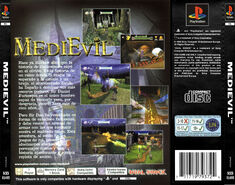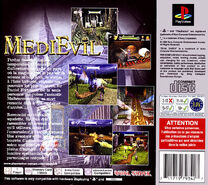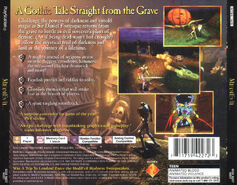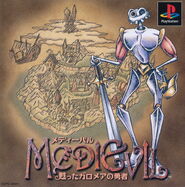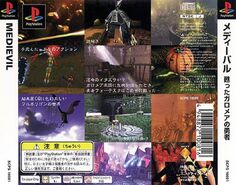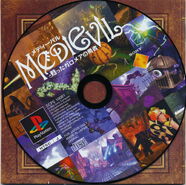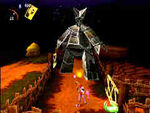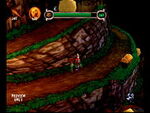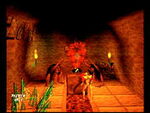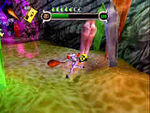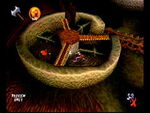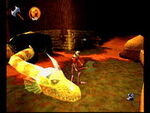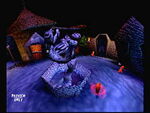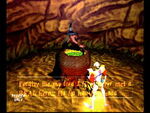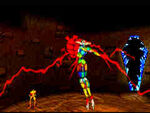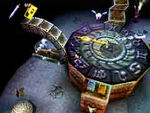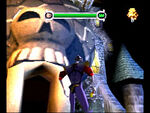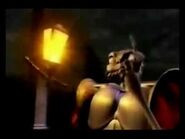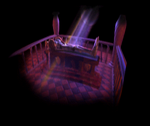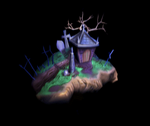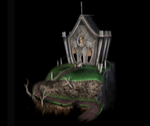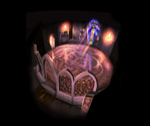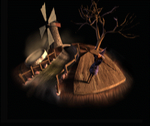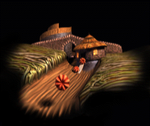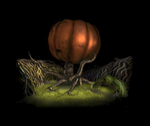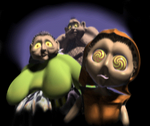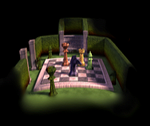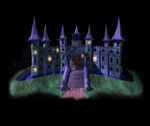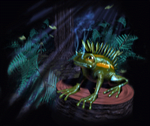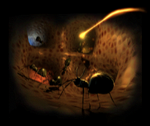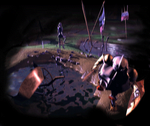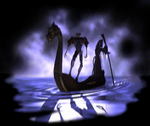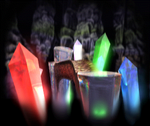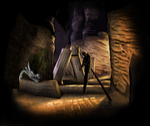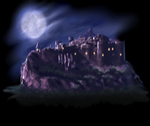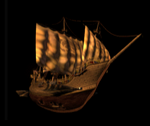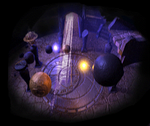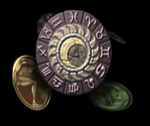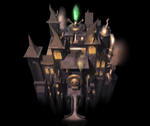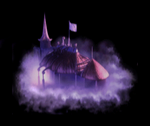| “Paths go this way, paths go that way...“ This article is about the first MediEvil game. For the series and the remake, see MediEvil (series) and MediEvil (PS4) respectively. |
MediEvil is an action-adventure video game and the first installment in the MediEvil series. It was developed by SCE Studio Cambridge and published by Sony. It was released on October 9, 1998 in Europe, October 21, 1998 in North America and on June 17, 1999 in Japan for the PlayStation. Due to its success, the game was released in September 1999 as a platinum title in Europe. It was also released in a bundle with C-12: Final Resistance on May 9, 2003.
The game was followed by MediEvil 2, released in 2000, and MediEvil: Resurrection, a reimagining released in 2005 for the PSP. The game was made available for download for the PSP, PlayStation 3 and the PS Vita via the PlayStation Store in 2007. A remake of the game for the PS4 was released in 2019.
Gameplay
During the game, the player must go through several places, from a graveyard full of zombies, to a flying ghost ship full of undead pirates, to a levitating board in an enchanted forest surrounded by flying demonettes. There are also several collectible items found in the levels which have to be collected in order to proceed to further areas or levels. There are several books placed upon stands all over areas in the game which may offer advice to Sir Dan, while some others contain humorous jokes or generally the history of the area. Some of them are placed in hidden places, but they are mostly found along the path that Sir Dan takes. They can be read if struck with a close-range weapon.
Weapons
Dan starts the game with just his detachable arm, which can be used as both a melee weapon and a projectile, but is incredibly weak. Soon, however he obtains a small sword. The majority of weapons Dan encounters are received from the Hall of Heroes by collecting Chalices in each level, and range from swords, axes and hammers to projectile weapons such as crossbows and spears. There are other weapons that Dan encounters through the course of the game, such as a club that can be used as a torch, but breaks after too much use; a Dragon Armour that lets Dan breathe fire and protects him from flame attacks; and Chicken Drumsticks that can turn enemies into Roast Chicken for health recovery. Dan is also able to find a variety of shields to protect himself, ranging from copper to gold in strength.
Chalice of Souls
Throughout the levels Sir Dan is presented with an opportunity to collect that particular level's chalice by filling it up with the souls of his enemies. This mystical item enables him to visit the Hall of Heroes after the conclusion of the level. Dan can only collect the chalice in each level when he has dispatched enough "defeated adversaries" to reach 100%. Chalices are hidden well and are not always at the end of a level, so Dan must back-track to the beginning to find it. In the "Hall of Heroes," he can converse with past heroes, "await spiritual guidance" and receive useful items or weapons to help him in his quest. Collecting all the chalices allows the player to see the true ending.
Enemies
Alongside certain weapons, there are also many colourful and varying enemies, though particularly zombies in the opening levels, which Dan must defeat. Later on through the epic journey through Gallowmere, Dan will encounter a number of other monsters and creatures, most of which are modelled after gothic demons associated with the time period. Sticky-fingered Imps, demonic Scarecrows, and Zarok's boiler guards are but a few of the ghastly and varied monstrosities that inhabit the levels. Very simple weapons will require much use in order to finish off a single enemy. Some enemies can only be attacked either at certain times or using specific weapons, such as the Scarecrows. Many weapons, such as swords and throwing daggers, can be charged up to produce a more powerful attack to finish beasts off more quickly.
Characters
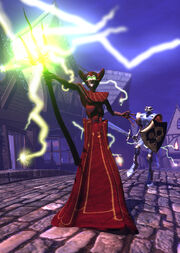
- Sir Daniel Fortesque - The game's protagonist and playable character. He was King Peregrin's champion when he was alive. He was also one of the first men to die in the battle against Zarok and his Shadow Demons and was proclaimed Hero of Gallowmere by the king so that the people of the land would feel safe. When Zarok returns to raise an army of the dead, he also raises Sir Dan by mistake. Being given a second chance, Dan can finally prove himself a hero that he wasn't in his life by defeating Zarok.
- Zarok the Sorcerer - The game's antagonist. He was King Peregrin's advisor and mage until he began dabbling in Necromancy, which led the King to exile him from the land. Embittered and filled with wrath, he led an army of Shadowy demons into battle against the King. His army was defeated, however, by the King's militia and soon he was proclaimed killed by Sir Dan. In truth, Zarok went into hiding, only to return 100 years later to try and take over the land once again.
- King Peregrin - The past King of Gallowmere. He appointed Sir Dan a knight and banished Zarok from the land. He aids Dan in his quest by telling him how to defeat the Shadow Demons.
- Heroes - Canny Tim, Stanyer Iron Hewer, Bloodmonath Skull Cleaver, Woden the Mighty, Karl Sturnguard, Dirk Steadfast, RavenHooves the Archer, Imanzi Shongama and Megwynne Stormbinder, all aid Dan in his quest by giving him their weapons and other useful items.
Plot
The game starts with a flashback in the 13th century in the fictional Kingdom of Gallowmere. It puts the player in control of Sir Daniel Fortesque: the reanimated skeleton of a deceased champion knight whom history holds in high esteem, due to his supposed heroics in battle against the evil sorcerer Zarok who, in 1286, had raised an army of demons and set out to take over the kingdom. The legend has it that Fortesque lead the King's army into battle against Zarok's demonic hordes and that Sir Daniel himself killed the sorcerer during the battle - despite having been mortally wounded at the outset - cementing his posthumous status as the "Hero of Gallowmere."
This official version of events is later revealed as being vastly exaggerated and that Sir Dan's entire reputation is based on a lie. It turns out that Fortesque was not a hero at all and was in fact the first to die during the Battle of Gallowmere as he was hit in the eye by an arrow while leading the first charge against Zarok's undead armies. Although Sir Dan's troops still managed to go on and win the battle without him, Zarok was able to escape and went into hiding, leading everyone to assume that he was dead. The "fog of war and the shrouds of time" ultimately conspired to portray Fortesque as being the great hero of the battle.
One century later, in 1386, Zarok unexpectedly re-emerges from the shadows, robs the citizens in a nearby village of their souls and awakens his undead army. But the waves of necromantic energy he has unleashed upon the countryside have unwittingly revitalized the skeletal corpse of Sir Fortesque, still missing the eye where he was hit and unable to speak clearly having lost his jawbone. Sir Dan pulls a cobweb out of his eye socket, shakes off the trauma and then grins at the player. Unable to go to the Hall of Heroes in death due to his failures in life, Sir Fortesque sets out from his crypt to exact his revenge upon Zarok and prove himself a true hero now that he has been given a second chance.
After finding a way out of the cemetery, getting through the rest of Gallowmere, making his way to the entrance of Zarok's lair and getting past every other obstacle the lair has, Dan finally makes his way to the lair's arena, where Zarok is waiting. There, Zarok sends out his fleet of skeletal warriors. But before doing this, Dan places one of the chalices he collected onto the white circle in the middle of the arena. This summons the souls belonging to the soldiers who fought in the war a century ago. Seeing that they are all ghosts, their weapons will affect Zarok's warriors, so they charge straight towards them and start fighting while Dan keeps his side alive by zapping them with good lightning (if the player fails to do this, Zarok's side will knock Dan out, resulting in an immediate game over.)
Once Zarok's side loses, Dan's warriors cheer while turning into health vials that Dan collects to get as much energy back as possible (he loses it while using the good lightning on his side). Zarok then summons his champion, Lord Kardok, a skeletal man wielding a mace and riding a skeletal horse. After Dan defeats him, Zarok finally has enough of Dan getting in the way and goes to his lab. There, he tries to turn himself into a monster capable of defeating Dan, while humorously having trouble casting the right spell. Zarok eventually gets it right and then enters the arena revealing himself to be a wingless dragon of some sort. The two fight, with Dan ending up victorious. Zarok then explodes into his normal form, while admitting defeat.
Zarok then gets up and states that if he is to fail, then all shall perish and that Sir Dan is doomed to stay in his lair forever. He then zaps the ceiling with his trident, which makes the roof cave in. While this happens, a big chunk of debris falls on top of Zarok with a humorous squeak. Dan then escapes and makes his way out to the arena entrance while the lair is falling apart. A small flying creature flies towards him, and then the two get blown back by the explosion of a sundial that was next to them. Dan manages to hang onto one of the floating cogs from The Time Device until he gets to a small cave. After brushing the dust off of his amour, Dan runs away from the fire caused by the lair's destruction, but he is unable to outrun it and the explosion sends him off the cliff. As he's falling to his doom, a giant vulture catches him and takes him back to his crypt while the stolen souls return to the people of Gallowmere. The vulture then drops him off at his crypt, which Dan re-enters and returns to his eternal rest.
Endings
The ending is determined by whether or not the player collected all the Chalices of Souls:
- Not all chalices collected: "After Dan returns to his eternal rest, the camera will zoom into the eye socket where Dan was not shot till the screen is completely black. The player is awarded a simple "The End" message. Then the credits roll.
- All chalices collected: The same thing happens, only this time Dan ends up going to the Hall of Heroes. When he arrives, the rest of the heroes have come to life (to the point where they're not even statues anymore) and are celebrating. They then notice that Dan has arrived and grown quiet, whispering about his accomplishment. Dan then does a few acrobatics on the table and lands into the central chair, where he catches a cup that he flipped into the air with his foot. One of the heroes fills it up with wine and Dan unsuccessfully drinks it (he is still in his skeletal form, therefore he has no throat). The other heroes then applaud Dan for finally having the courage to defeat Zarok once and for all. The camera then zooms out of the Hall and into the sky, where it shows a constellation of Dan in his heroic stance. "The End" message pops up and the credits roll.
Development
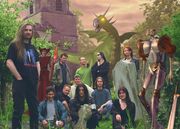
The MediEvil development team.

The Making of MediEvil
The Making of MediEvil

MediEvil's Minds
MediEvil's Minds

MediEvil's Design History
MediEvil's Design History
Development of MediEvil started in 1995 at independent developer Millennium Interactive. Chris Sorrell, previously known for the James Pond series, created the original concept for MediEvil and served as the game's creative director. Prior to the development of MediEvil, Sorrell had endured a rather torrid time working on some edutainment products that Millennium Interactive had signed up to create. "Once these products were finally complete, I think management took pity on me and rewarded me with the chance of making my dream game" he recalls. According to Sorrell, the first design proposal for the game had the working title ‘Dead Man Dan’ and described a game that was a fusion of Capcom's Ghosts 'n Goblins with the art style of Tim Burton – especially the look and feel of The Nightmare Before Christmas, both of which were things that he was a huge fan of back in the mid-'90s. Lead artist and designer Jason Wilson shared his interest in dark, Gothic influenced artwork and they worked together to define the look and feel of the game. Wilson was particularly inspired by German Expressionism from the 1920s and credits films such as Der Golem, The Cabinet of Dr Caligari, Nosferatu, Metropolis and Sunrise as his main sources of inspiration.[13] As development progressed, Wilson pushed the game into more of a Zelda-like direction as opposed to the original arcade-style concept. Sorrell approved of the new direction and said that he would liked to have expanded more on it.
From the outset, Sorrell wanted his game to possess a unique lead character. They worked with a script doctor named Martin Pond when looking for more of a backstory for the lead protagonist, Sir Daniel Fortesque. Pond came up with the idea that Sir Daniel could have been a pompous failure in life whose reincarnation was his one shot at redemption.
In addition to bringing together a brand new team – none of whom had really made a 3D game of this scale before – they were in 'sell' mode almost from day one, with the future of the studio riding on their ability to attract a major publishing deal as quickly as possible. They were initially working on multiple platforms including Windows and Sega Saturn as well as PlayStation before finally having the chance to pitch an early demo to Sony, who were so impressed with their work that they bought the whole studio and became Sony's second United Kingdom development studio. Late in the game's development, Sony requested that MediEvil should support the (then) new PlayStation analogue controller, which Sorrell described as a "particularly fortuitous event" as it allowed them to capture much more fluidity and intuitiveness within the game.
Sorrell said that MediEvil presented a mountain of challenges due to the fact that, like many other developers at the time, they were still very new to 3D gaming. Things like camera and character control presented many interesting new challenges and required the team to try out a number of approaches before settling on solutions that seemed to work. He said that they spent many long nights without sleeping, trying to finish the game. There were also many levels and ideas from the original concept that they were forced to remove because of time and budget constraints. In most cases, the best of what they had already created for those levels ended up being spliced into the levels that they shipped with. There was also intended to be a platform-oriented section of the game where the player would control the worm that lived in Daniel's skull. Concept art and a level ost was created for this section, but it never materialized into the game. Even so, Sorrell said that the game still came very close to the original concept and he was most proud of how the team pulled together to finish the game without compromising on the quirky attention to detail or scope of the game.[14]
Tools
Graphics
- Alias PowerAnimator - Used for creating the FMV models and rendering them on an SGI machine.
- Avid Matador - Used to create textures for the FMV models.
- N-World - Used for creating in-game 3D models.[15]
- Photoshop 2 - Used for creating in-game textures.[15]
Music
The following tools, CD samples and software were used to create the game's original soundtrack[16]:
- Roland JV1080 synthesizer
- Akai S3200 sampler using Peter Siedlaczek's "Orchestra", "Advanced Orchestra" and "Classical Choir" sample CDs
- Symphonic Adventures CD
- Emagic Logic Audio 3
- Digidesign Protools III PCI
Software Development
- Psy-Q Development Kit
Cover art and CDs
Additional content
Inside copies of the platinum version of the game's PlayStation box was a poster featuring an insight into MediEvil's sequel, MediEvil 2. This detailed new characters and levels, set in 19th century London.
On the reverse of this image are map instructions for the first four levels of the game. These include details of the locations of vials, the chalice, life bottles, rune stones, gargoyles, rune hands, copper and silver shields, primary weapons and other secrets which may only be accessible after finding certain items or completing specific tasks.
Soundtrack
- Main article: Les musiques de MediEvil
The original soundtrack of the game was made using electronic synthesizers to simulate an entire orchestra and organ. Paul Arnold and Andrew Barnabas composed the tracks. Chris Sorrell, the game's director, asked them to compose a Danny Elfman-style score, similar to those of Beetlejuice, The Nightmare Before Christmas and Batman Returns.[17]
Although there's no official soundtrack release, the 71st issue of the french magazine Joypad featured a CD named "Les musiques de Medievil," which contains ten tracks from the game and is the only "soundtrack" ever released for it.
Tracklist
| # | Track title | Composed by | Length |
|---|---|---|---|
| 1 | "The Awakening" | Andrew Barnabas, Paul Arnold | 2:12 |
| 2 | "Quest for Vengeance" | Andrew Barnabas, Paul Arnold | 2:10 |
| 3 | "Dan's Waltz" | Andrew Barnabas, Paul Arnold | 2:05 |
| 4 | "A difficult path" | Andrew Barnabas, Paul Arnold | 2:08 |
| 5 | "Morten's Dance" | Andrew Barnabas, Paul Arnold | 2:00 |
| 6 | "Enchanted Wood" | Andrew Barnabas, Paul Arnold | 2:09 |
| 7 | "Desecrated Church" | Andrew Barnabas, Paul Arnold | 2:14 |
| 8 | "Journey through the Crystal Caves" | Andrew Barnabas, Paul Arnold | 2:18 |
| 9 | "City in the Clouds" | Andrew Barnabas, Paul Arnold | 2:09 |
| 10 | "Triumph in Death" | Andrew Barnabas, Paul Arnold | 2:42 |
| 11 | "Stuttgart (Exciting)" | Jason Page | 3:20 |
| 12 | "Stuttgart (Panic)" | Jason Page | 3:05 |
| 13 | "Japan" | Jason Page | 3:15 |
| 14 | "USA" | Jason Page | 3:10 |
| 15 | "Alpine" | Jason Page | 3:45 |
| 16 | "Menu" | Jason Page | 1:54 |
Release
Reception
| Reception | |
|---|---|
| Aggregate scores | |
| Aggregator | Score |
| GameRankings | 80.40%[18] |
| Review scores | |
| Publication | Score |
| Absolute PlayStation | 91%[19] |
| Electronic Gaming Monthly | 7.8/10 |
| Game Revolution | A−[20] |
| GameSpot | 8.2/10[21] |
| IGN | 7.8/10[22] |
| Official PlayStation Magazine (US) | 4/5 |
| PSM | 3/5 |
| PSX Extreme | 6.9/10[23] |
MediEvil received mostly positive reviews, with an 80.40% aggregate rating on Game Rankings.[18] The game received a 7.8/10 from IGN.[22] IGN heralded it as "A fun game and one of PlayStation's classics". GameSpot gave it an 8.2/10, proclaiming that the game is a "welcome surprise".[21] Game Revolution gave the game an A− and stated that "what we have here is one of the cleverest platform games ever made".[20]
According to Jason Wilson, market research for the game in 1998 revealed that the game scored very highly with female gamers, especially in France.[24]
Sales
The game sold over 800k units world-wide by November 1, 1999.[25]
Credits
| Game Concept/Direction | Chris Sorrell |
|---|---|
| Game Design | Jason Wilson |
| Main Programming | James Busby, Paul Donovan, Chris Sorrell, Matt Johnson, Sam Baker |
| Additional Programming | Derek Pollard, Tim Closs, Dean Ashton |
| Mapping/Development Assistant | Katie Lea |
| Art Design | Jason Wilson |
| Rendered Sequences/Presentation Visuals | Jason Riley |
| Additional Mapping | Lindsay Pollard |
| AV Management | Pete Murphy |
| Original Soundtrack | Andrew Barnabas, Paul Arnold |
| Sound Effects | Paul Arnold |
| Video Post-Production | Tom Oswald |
| Speech Post-Production | Andrew Barnabas |
| Sound Effects/Language Implementation | Gary Richards, William Bell |
| Technologies Management | Mike Ball |
| Technologies Programming | Andrew Ostler, Dean Ashton, Matt Johnson |
| QA Testing Co-ordinator | Sarah-Louise Lloyd |
| QA Testers | Dave Holloway, Alex Sulman, Dan Smith, Stuart Harvey |
| Preliminary Script | Jason Wilson |
| Dialogue Script | Martin Pond |
| Producer | Chris Sorrell |
| Manager (Cambridge Studio) |
Ian Saunter |
| Executive Producer for SCEE | John Roberts |
| Product Manager | Chris Ansell |
| Manual | Written by Jim Sangster
Designed by Steve O'Neill |
| Print Production | Martin Pearce |
| Manual QA Approval | Lee Travers, Stephen Griffiths |
| QA Manager | Tony Bourne |
| Head of the Internal Testing | Steve Archer |
| Testing Co-Ordinator | Jim McCabe |
| Lead Tester | Dave Burke |
| Assistant Lead Tester | Andy Macoy |
| Testers | Ian Cunliffe, Richard Bunn, Anthony Gill, John Cassidy, Dominic Berzins, Ian McEvoy, Phil Bramhill, Dee Norfolk, Lorna Croasdale, Pat Cowan, Carl McKane, Carl Guinney |
| Lead Localisation Tester | Ed Valiente |
| Localisation Testers | Claudia Schuldt, Christa Leonards, Lucie Dupoirieux, Susana Olga Paredes Alcaraz, Ana Maria Juarez-Ordóñez, Andrea Masneri, Miguel Sanchez |
| VOICE ARTISTS | |
| Luis Soto, Paul Darrow, Harry Dickmen, Christopher Kent, Helen Lederer |
Gallery
Official screenshots
Videos
Trivia
- MediEvil was one of the first games to support a DualShock controller on the PlayStation.
- The PAL version of the game is the first known PlayStation game to use LibCrypt protection.[26]
- On the game's official US website and on promotional game material, it is said that the game takes place in 847, but this is retconned in the game's sequel, where the year 1386 is revealed to be the true year of the game's events.
- MediEvil is dedicated to the memory of Mr Apple.[27]
- Within the game's memory, the following message can be found: "Buzby sucks eggs, and Eastwood smells!"[28] This refers to James Busby, the game's lead programmer, who left the project about two months prior to its release as a result of creative differences.[29][30]
- The game's logo is made using the Ticonderoga font by Altsys Fontographer 3.5. The Japanese version uses a modified iteration of the Harrington font by Sam Wang instead.
- The Japanese version of the game contains numerous differences, such as Daniel wearing a helmet.
- From August to September of 2010, "MediEvil" was made available for free to European PlayStation Plus subscribers.[31]
In other languages
| Language | Name | Meaning |
|---|---|---|
| Chinese | 骷髅战士MediEvil | Skeleton Warrior: MediEvil |
| Japanese | メディーバル 甦ったガロメアの勇者 | MediEvil: Resurrected Hero of Gallowmere |
| Korean | 메디이블 | Same as English. |
See also
 MediEvil fan comic.
MediEvil fan comic. MediEvil fan film.
MediEvil fan film. MediEvil: Hero of Gallowmere mod for The Elder Scrolls V: Skyrim.
MediEvil: Hero of Gallowmere mod for The Elder Scrolls V: Skyrim. MediEvil: Undead Again fan game.
MediEvil: Undead Again fan game.
References
- ↑
 Welcome on MediEvil Official EU Website (archived version).
Welcome on MediEvil Official EU Website (archived version).
- ↑ Challenge the Powers of Darkness in the Gothic World of MediEvil in Business Wire. Published October 21, 1998.
- ↑ Nelson, Randy & Perry, Douglass, MediEvil on IGN. Published October 22, 1998.
- ↑
 MediEvil® (PS3™/PSP®/PS Vita) on US PlayStation Store.
MediEvil® (PS3™/PSP®/PS Vita) on US PlayStation Store.
- ↑ メディーバル 甦ったガロメアの勇者 on プレイステーション® オフィシャルサイト.
- ↑ MediEvil on Pegi Public Site.
- ↑ MediEvil on نظام ارزیابی و رده بندی سنی بازی های رایانه ای.
- ↑ MediEvil (PS One) on ESRB.org.
- ↑ MediEvil (PS3, PS Vita, PSP) on ESRB.org.
- ↑ Medievil® (메디이블®) on 게임물관리위원회. Published April 27, 2011.
- ↑ MEDIEVIL on Australian Classification Board. Published January 9, 1998.
- ↑ MediEvil on Unterhaltungssoftware Selbstkontrolle. Published August 5, 1998.
- ↑
 Jason Wilson, Reference and inspiration for the game MediEvil on Facebook. Published November 3, 2014.
Jason Wilson, Reference and inspiration for the game MediEvil on Facebook. Published November 3, 2014.
- ↑ Fred Dutton, Behind the Classics: MediEvil on PlayStation.Blog. Published September 7, 2012.
- ↑ 15.0 15.1 jason wilson medievil design history on atomic-city concept art and design of Jason Wilson (archived at Wayback Machine Internet Archive).
- ↑ Medievil 2 case study on Bob and Barn (archived at Wayback Machine Internet Archive).
- ↑ Oliver Ittensohn, Interview with composer Paul Arnold on GSoundtracks. Retrieved 18 May, 2012.
- ↑ 18.0 18.1 MediEvil for PlayStation on GameRankings.
- ↑ MEDIEVIL - Review on ABSOLUTE PLAYSTATION (archived version). Published November 1998.
- ↑ 20.0 20.1 MediEvil Review on Game Revolution. Published October 1998.
- ↑ 21.0 21.1 Joe Fielder, MediEvil Review on GameSpot. Published October 23, 1998.
- ↑ 22.0 22.1 Randy Nelson and Douglass Perry, MediEvil on IGN. Published October 22, 1998.
- ↑ Medievil Review on PSX Extreme. Published July 7, 1999.
- ↑ "During market research for the game in ‘98, MediEvil was found to score very highly with female gamers, especially in France. Women found Sir Dan an appealing character and different to usual macho game characters." — Jason Wilson on Twitter. Published October 9, 2018.
- ↑
 Press Release on MediEvil 2 Official Website (archived version).
Press Release on MediEvil 2 Official Website (archived version).
- ↑ SBI FILES on The PlayStation Datacenter.
- ↑
 MediEvil, Credits. Developed by SCE Cambridge Studio. Published by Sony Computer Entertainment on October 9, 1998.
MediEvil, Credits. Developed by SCE Cambridge Studio. Published by Sony Computer Entertainment on October 9, 1998.
- ↑
 Hidden Programmer Message on MediEvil Boards. Published January 28, 2012.
Hidden Programmer Message on MediEvil Boards. Published January 28, 2012.
- ↑
 Interview with Jason Wilson on MediEvil Boards. Published February 10, 2012.
Interview with Jason Wilson on MediEvil Boards. Published February 10, 2012.
- ↑ RETRO Volume 8, page 130. Published in 2015 by Imagine Publishing Ltd.
- ↑ PlayStation Plus Content For August And September on PlayStation.Blog.Europe.
External links
| |||||||||||||||||||||||||||||||||||||||||||||||||||||||||||||||||||||||||||||||||||||||||||||||||||||||||||||||||||||||||||||||||||||||||||||||||||||||||||||||||||||||||||||||||||||||||||||||||||||||||
|




